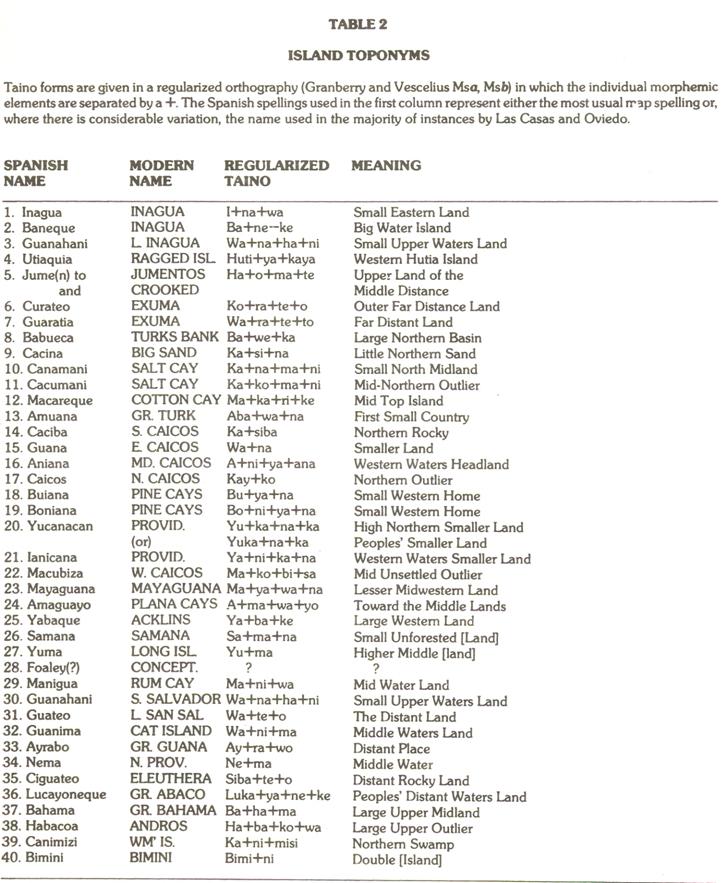Julian Granberry writes: A few of the aboriginal names of the islands of the Commonwealth of the
Bahamas and the Crown Colony of the Turks & Caicos Islands - the Lucayan
Archipelago - have survived intact to the present: Abaco, Bahama, Bimini,
Caicos, Exuma, Guana (in several places), Inagua, Jumen-to, Mayaguana, and
Samana. Abaco and Exuma are now applied to islands other than those they first
designated, if we are reading the early maps correctly, but the others still
designate the islands they originally named. The names of many others are also
known from the writings of Spanish chroniclers and maps of the early 16th
century. In all we have 40 aboriginal island names.
Until recently there has been no attempt to determine what, if anything,
these names meant and what significance such meanings might have in determining
the order of settlement, extent of occupation, cultural differences, and
relative importance of the individual islands. The names have been listed, of
course, with varying degrees of accuracy and there has been speculation as to
the import of some of them, but the lack of information on the language they
were part of made even guess-work difficult.
Correlating the native names with specific islands in the archipelago is
itself not an easy task, for the early maps often dislocate individual islands
and frequently give them shapes which are only partly a function of actual
geography. In 1953/54, using the beautifully reproduced maps of the Duque de
Alba's
Mapas Espanoles de America, Siglos XV-XBII (Academia
Real de la Historia 1951) and other maps and reproductions available at the
P.K. Yonge Library of Florida History at the University of Florida, I
correlated the names and locations of the islands in the archipelago from the
principal maps of the early 16th century, particularly those of Juan de la Cosa
(1500), Alberto Cantino (1502), Freducci d'Ancona (1514/15), the Turin map
(c1520), Juan Vespucci (1526), and Alonso de Santa Cruz (1545) (Cranberry
1955:23-31). I have since added correlations from a number of other maps, such
as that of Alonso de Chaves (c1526). Recently Josiah Marvel has embarked on a
scholarly listing and correlation for 320 cartographic and manuscript sources
listing Lucayan island names (Marvel 1988). Our correlations are largely in
agreement, though there are a few discrepancies.

|
The mere reading of the cartographic names is often a difficult task, for
variant spellings abound. One is often forced to the assumption that the
map-maker himself introduced aberrant spellings for individual names, all of
which must have been totally exotic and unfamiliar to him. This seems
particularly true of maps whose primary task was to chart areas other than the
Caribbean itself. Where individual island names occur in Las Casas'
Historia
de las Indias (1875), that spelling has been taken as definitive.
The translation of Lucayan names posed additional problems, for it had
simply been assumed without verification that Arawakan Taino, the general
language of the Greater Antilles, was also the language of the islands -
Columbus' Guanahani interpreter was able to converse with the natives of Cuba
(Fuson 1987:100, 103, 107, etc.).
In the late 1950's the present writer and a colleague, the late Gary S.
Vescelius, former Territorial Archaeologist for the U.S. Virgin Islands,
independently began to examine both the surviving Taino lexicon and the native
place-names of the Greater Antilles with the object of adding to the number of
translatable Taino forms and of determining the method by which the Taino named
their settlements. In 1978 we began to consolidate our research efforts. After
Mr. Vescelius' untimely death some years later, I obtained his linguistic and
toponymic notes, and I am in the final process of completing our joint
venture'(Cranberry and Vescelius Ms
a, Ms
b).
If you are interested in the full text
of the article, you may order this issue of our 1990 Journal for B$5.00 plus
shipping & handling by contacting the society.
All past Journals sell at $5 ($3 for students)
The 2009 Jubilee Journal sells at $10 ($7 for students)
Full set of 31 Journals: $110
Our next talks are:
Thursday
25th
February 2010 at 6pm Talk
‘Over-the-Hill’ Grants Town by Sir
Orville Turnquest.
The Bahamas Historical Society (BHS)
is a non-profit organization dedicated to stimulating interest in
Bahamian History and to the collection and preservation of material
relating thereto. Its Headquarters, the former IODE Hall, was a gift
from the Imperial Order of the Daughters of the Empire (IODE). BHS is
on Shirley Street and Elizabeth Avenue in Nassau.
www.bahamashistoricalsociety.
com
